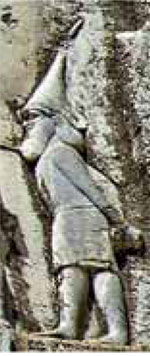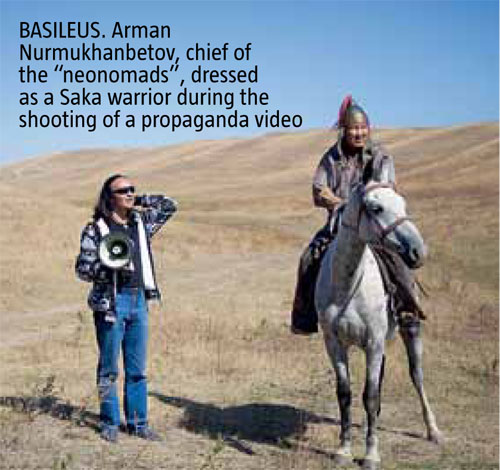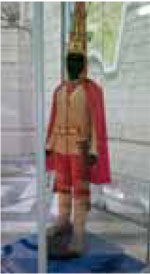The Ukrainian Week continues its series of articles on ancient peoples that inhabited Ukrainian lands and left behind a distinct historical legacy. This article looks at the Asian Scythians, known as the Saka. They left their mark on the Crimean topography, and today both official Astana and modern-day followers of neonomadism followers appeal to their legacy.
According to the Greek historian, Ephorus, these warrior, cattle breeding and farming tribes came to Asia from the land which is now part of Ukraine, with which they maintained an intimate connection throughout their history. They lived south of what is today Kazakhstan, in Uzbekistan, northern Kyrgyzstan and the Altai Mountains. Written records from Hotan convincingly proved that they were Iranian-speaking. Caucasian, white-skinned and blue-eyed, the Saka were the closest relatives of the Scythians that lived north of the Black Sea. The two groups communicated and engaged in commerce on a regular basis.
SKILLED ARCHERS
Like the Black Sea Scythians, the Saka believed that human blood had mystical powers and identified gold with the sun, fire, supreme power and eternal life. The Saka tribes also worshipped the sword and had other sacred artefacts. The Roman historian, Quintus Curtius Rufus retells the legend about the Saka in which they, just like the Scythians from the Dnipro region, had magical gifts from heaven: a plough and a yoke for farmers; a spear and an arrow for soldiers; and a sacrificial cup for priests.
This suggests a division of the Saka society into three groups: warriors (the ancient Indo-Iranian name for warriors, “rataishtar” – “those who stand in a chariot”), priests with their characteristic sacrificial cup and specific headgear and communal farmers, or the “eight-legged”, i.e., those who had two oxen that could be yoked to a plough. Each caste had its own traditional colours: red and golden-red for warriors, white for priests and blue and yellow for farmers. For centuries, the combination of the last two was inherent in the symbolism of the population of the northern Black Sea region and found its contemporary embodiment in Ukraine’s national flag.

A NOMADIC PEOPLE. A Saka horseman from the Pazyryk culture, the Altai Mountains, 300 BC
The chiefs of the Saka tribes belonged to the warrior caste. The Greeks called them Basileus (plural Basileis), i.e., tsars, whose attribute was a bow and arrows. A tsar would pass his weapons on to the son who succeeded him to the throne. It is no coincidence that archery and the ability to hit a target accurately was considered to be a mark of nobility. It was tested during all kinds of celebrations. According to an ancient tradition, the best archer received the right to rule over people for the duration of such festivities.
Just like the medieval princes in Ruthenia-Ukraine, a Saka tsar would plough the first furrow in spring and would be raised by a shepherd, which showed his connection to the people. A Basileus was a member of the military caste and, at the same time, was considered to be chosen by the gods, a mediator between heaven and earth, the centre of the Universe and the carrier of earthly prosperity. The welfare of the people depended on his physical strength and spiritual energy. He was the embodiment of all societal strata. Saka women enjoyed equal rights with men, and the names of their warrior queens, Tomyris and Zarina, have been preserved though the ages.

A GOD-GIVEN KING. Skunha, Tsar of the Saka, 6th century BC
THE RULERS OF SAKASTAN
For a while, the Saka were ruled by the Persian Empire and later by Alexander the Great. In an effort to free themselves from their neighbours, the Saka-Massagetae moved to the Caucasus and what is now southern Ukraine, where they joined the new masters of the Ukrainian steppes, the Alans. They stayed there until the early Middle Ages. Byzantines greatly valued the Massagetae from the Dnipro region as guards, warriors-spearmen and skillful scouts, who could easily extract information from the enemy.
Another part of the Saka tribes went south and occupied part of what is now Iran and Afghanistan, establishing its own state, Sakastan. From there they penetrated northwest India and founded a series of their own states in the late 2nd and first half of the 1st century BC. The Chinese called this heroic people the Sai and Indians – the Śaka. One of the most prominent Saka rulers was King Mai whose authority extended over Gandhara, the Swat Valley and even part of Kashmir. His successor Az expanded the kingdom and assumed the title “Great Tsar of Tsars”.
The Saka spread all the way to southern India and even what is now Cambodia and were mentioned in the Puranas, Manusmrti, the Ramayana, the Mahabharata and other ancient Indian texts. Saki, a city in India, reflects their contribution to Indian topography and has a namesake in the citry of Saky in the Crimea, also founded by the Saka.

A PROMOTER OF NEONOMADISM. Beken Nurmukhanbetov, the Director of the Issyk Historical and Archaeological Museum, actively exploits the history of the Saka in the interests of pan-Turkism
Like the Scythians living north of the Black Sea, the warrior Saka worshipped the Serpent goddess, a mythical primogenitor of their people, and the Indian god Varuna, a counterpart of Thagimasidas, a sea god and the forefather of the Scythian royal dynasty. The ruthless customs of the Saka tribes instilled fear in the Indians. For example, if a prominent warrior was killed, his enemies were buried alive with him. This custom survived in the Black Sea region long after the Scythians were gone, for example, among the Zaporizhzhian and Kuban Cossacks.
It is with good reason that Buddhism was popular among the Scythians in Asia. Some sources suggest that the Gautama Buddha, whose father was a king from the Kshatriya warrior social order, was of Saka origin. HisThe title “Sakyamuni” means “the wisest of the Saka”. At the age of 16, he was married to his cousin Yasodhara, a daughter of a local Saka King Suppabuddha. The name of a Scythian tribe, the Budini, living along the left bank of the Dnipro River are reflected in the names of Buddha and his father-in-law and at the same time, uncle. They were distant relatives of the famous “Golden Man” from the Issyk kurgan (burial mound), from which a silver goblet has an inscription, that has yet to be deciphered.
THE APPROPRIATION OF A LEGACY
In the spring of 1970, a group of scholars from the Kazakh Academy of Sciences, led by renowned archeologist Alisher Akishev, excavated one of the kurgans near Issyk, a city located 50 kilometres east of Almaty. Under an inscription in a piece of wood, they found the tomb of a prominent warrior, buried in a wooden casket. His tall and pointed hat, shirt, caftan, loose trousers and boots were decorated with golden plates depicting snow leopards, horses, mountain goats and wild mountain rams, all done in the Scythian animal style. There was a golden torc around his neck, gold rings on his fingers and a gold earring in his left ear. Weapons, such as a sword with a golden hilt, a dagger, a golden arrow and a whip, decorated in gold, lay next to the buried man.
A total of 4,800 gold adornments were found in the kurgan, which is the second highest number ever found in tombs, topped only by that of Tutankhamen. Radiocarbon dating estimated the age of the finds to be from the 5th century BC. The deceased was determined to be no more than 18 years old. The scholars were in no doubt that he was the young king of the Saka, or Asian Scythians, who were mentioned by Herodotus, Strabo, Pompeius Trogus and in ancient cuneiform Persian sources.

The sensational discovery of the intact tomb of a Saka king made Issyk famous across the world. The “Golden Man” perched on a winged snow leopard became one of the Kazakh national symbols: copies of the Saka warrior have been constructed in many of the country’s cities, and one even crowns the Independence Monument in the main square of Almaty. The flag of the Kazakh president also features a figure of the young king.
After Kazakhstan became independent, its official historical science has been persistently promoting the claim that the Saka were Mongoloid and that they were the “glorious ancestors of the Turkic people”. Archeologist Beken Nurmukhanbetov, who was fortunate enough to witness the famous excavations in Issyk, was one of the people behind this theory.
In 1992, when President Nursultan Nazarbayev was planning a trip to New York, and intended to take a copy of the “Golden man” as a present, he met Nurmukhanbetov at a preparatory exhibition. Of course, the symbol of an independent Kazakhstan could not be relinquished to neighbouring Iranians or “random” scholars, so Nurmukhanbetov was officially proclaimed the discoverer of this unique find.
Four months later, he was appointed Director of the newly established Issyk Historical and Archaeological Museum and Reservation and founded the Altyn Adam Association. He officially took all tourism related to the “Golden Man” into his own hands and actively promoted pan-Turkic ideas.

THE NATIONAL SYMBOL. A scale model of the “Golden Man” in an Issyk museum
One of his sons is the leader of the Neonomad NGO, the biggest Kazakh extremist group. According to Ukrainian human rights advocates in Kazakhstan, since 2009, its fighters have made at least 50 attacks, based on national hostility. They began as Tengri neo-pagans and ended as blatant chauvinists. As the speeches of the group’s leader clearly suggest, their goal is “the new expansion of nomads”, i.e., ethnic cleansing in Kazakhstan and other “ancient Turkic” territories, including the Northern Caucasus, southern Ukraine and the Crimea.
The group was notable for its participation in a coup in neighbouring Kyrgyzstan, where they were remembered for their anti-European and anti-Semitic slogans. Xenophobia is the most important component of neonomad ideology, which dictates freedom from Europocentrism and the “Greek-Judean matrix”. These radicals tell Kazakh youths that white people invented money, the banking system, loans, the education system, the Nobel Prize and historical science in order to enslave others. As far as history is concerned, their pet peeve is that historical science fails to mention that Turkic Kazakhs were the first to smelt iron, domesticate horses, invent the wheel, and make the first vault.
Russia’s ill-famed Eurasian Youth Union is happily helping the “neonomads”. The Russian organisation is also actively supported by official Astana. For example, with the support of the Kazakh Ministry of Tourism and Sports, Nurmukhanbetov has made several propaganda videos of a chauvinistic nature which included Saka-related plots.
It is highly unlikely that the ancient Saka, the knights of the steppe who put truth above all else in life, would agree to have anything to do with these pan-Turkic chauvinists. The “Golden Man” and his people have become hostages to the primitive misanthropic propaganda of the Kazakh extremists.

